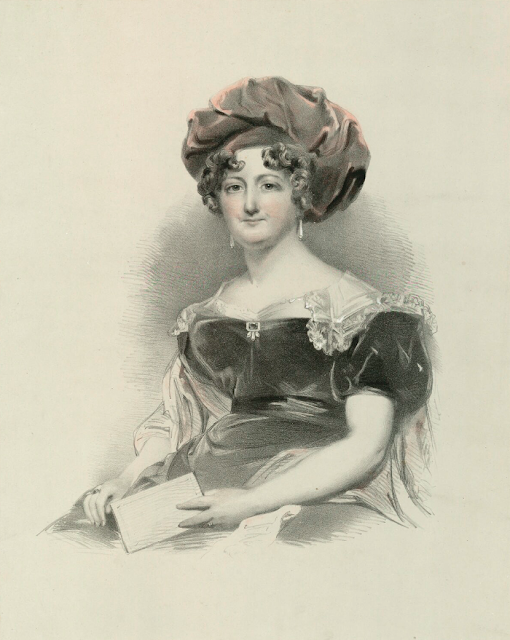 |
Princess Mary, Duchess of Gloucester and Edinburgh. Picture (c) National Portrait Gallery, London. |
The following are the contents of a letter written by the Princess Mary, daughter of King George III and Queen Charlotte, to Lady Harcourt in 1816. The princess elaborates on how she has decided to wed her first cousin, the Duke of Gloucester. Prince William, Duke of Gloucester, and Princess Mary, Duchess of Gloucester, were married for eighteen years before the death of the duke; the couple did not have children.
My very dear Lady Harcourt,
I found your most kind and affectionate note on my table late night on my return from Windsor. I never could doubt all your kind feelings on hearing of my intended marriage; and I am unhappy I did not write myself to you, as I look upon you quite as a 2nd mother, & respect you as such; but the real truth is, that, though the Q. and Prince gave their consent on Saturday, & felt satisfied all was settled, I was not quite so myself untill last night. However, I started a subject to the D. of Gloucester that required a very decided answer, before I could make up my mine to change my intention. I got a satisfactory answer last night through the D. of York, therefore I can now say we compleatly understand each other. When I see you I will explain this.
I don't know what other people feel when going to be married, but as yet I have done nothing but cry. I have been half killed with the kindness of the Queen and all my Brothers & Sisters, & such a day as I passed at Windsor yesterday is more than I can describe. That dear Castle, which contains all I value in this world; that dear place, in which I have passed so many happy days; that spot in which my most valuable & respectable Father is incircled. That, Alass, I am not to receive his Blessing and approbation, with those of all the rest of the family, half kills me; and the idea of heaving that House at Moments half breaks my heart. But the D. of Gloucester has so kindly entered into all my feelings, so faithfully promised that I shall be as much with my family as possible, and is so convinced how it is in my power to do my duty as his wife, as well as to do my duty at Windsor (to a certain degree), that it makes me thank God.
His house is so near, only 3 miles, as to admit of all this.
Yours affectionally,
Mary.
Source: The Royal Dukes and Princesses of the Family of George III: A View of Court Life and Manners for Seventy Years, 1760-1830 (Volume 2) by Percy Hetherington Fitzgerald, 1882.
As we conclude our exploration of Princess Mary's letter to Lady Harcourt, it is evident that the intricacies of royal family dynamics are a fascinating subject. The candid account of her emotional journey to marriage with the Duke of Gloucester provides a unique glimpse into the complexities of royal life, where personal feelings and duty often collide. The princess's struggles to secure the approval of her family, particularly her mother, Queen Charlotte, highlight the delicate balance that exists within these esteemed circles. It is crucial to recognize the significance of these historical events in understanding the evolution of royal family relationships and the societal norms that shape them.
As we reflect on Princess Mary's story, it is clear that her experiences are a testament to the enduring power of family ties and the resilience of those who navigate the challenges of royal life. The letter serves as a poignant reminder of the emotional toll that these decisions can take on individuals, particularly women, who are often expected to prioritize duty over personal desires. The story of Princess Mary, Duchess of Gloucester and Edinburgh, is a compelling example of how the intricacies of royal family dynamics continue to captivate and educate us about the complexities of human relationships. It is our hope that this article has provided a valuable insight into the life of Princess Mary and the world of royal family dynamics, and we invite you to continue exploring the rich history of European royal families through our blog.





No comments:
Post a Comment